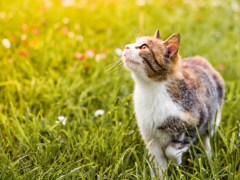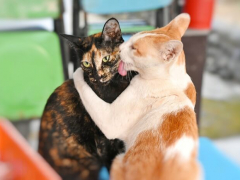
SNeG17 / Shutterstock.com
For many cat owners, when cats bunny kick, they see an instantly recognizable move. When it happens, the cat will wrap their front legs around an object, and then kick at it frantically with their rear legs. Not surprisingly, this typically appears to be a sign of aggression. Certainly damage can be done by sharp teeth and claws during a particularly intense bunny kick.
Key Takeaways
A cat bunny kick is a common behavior where the cat holds an item with its front legs and kicks hard and fast at it with the hind legs
Bunny kicking can be a form of aggressive self-defense, a hunting strategy, or a playful form of wrestling
Avoid painful bunny kicks by using appropriate toys to burn off your cat’s pent-up energy and never let them play with your hands or feet.
When a cat bunny kicks in this matter, it can be hard to tell what the reason behind it is. Let’s take a closer look this behavior and decipher its meaning.
3 Reasons Why Cats Bunny Kick
Cat behavior is quirky, but there is usually a reason behind every feline maneuver. So, do cats bunny kick just for fun and to release some pent-up energy? Or is this a more aggressive behavior? Let’s look at the common causes.
1. A Self-Defense Move
In the wild, cats are predators – but they can also become prey. Flexible and agile, cats are well built to escape their adversaries. Still, there are situations where they need all the help they can get to fight off an opponent. With sharp teeth and multiple sets of claws, cats use their strong back legs to protect themselves. If pushed onto their back, a cat’s belly is exposed. This is an extremely vulnerable position for them to be in. Natural instincts set in, and the cat will engage the muscles in their rear legs to come up to kick and scratch fiercely at their attacker with sharp claws.
Some cats will use this kicking tactic if they are overstimulated, stressed or excited. This can happen during a particularly exuberant play session, or when something happens to startle them, such as a loud noise or sudden movement. Many cats will bunny kick if their abdomen or feet are touched, as these are very sensitive areas.
A cat’s bunny kick can also be an aggressive move, but most cats will inflict physical harm as a last resort in any conflict.
2. As a Hunting Maneuver
Cats are stealthy and quick, making them excellent hunters. Their hunting instincts are well honed from birth. The cat bunny kick is often used by both wild and house cats as part of a tried-and-tested method of catching and killing their prey.
The cat will hold their catch with their front paws, keeping it well restrained while they inflict more damage with their hind feet and mouth. As all cat owners know, their teeth and claws can exert much damage through bites and scratches.
3. Playtime Fun

Cats are natural hunters, so expressing hunting instincts during play is common. Garmasheva Natalia / Shutterstock.com
As hunting is a natural behavior in cats, the necessary skills are developed through active play. Most cats are highly motivated to play, and their playtime usually involves pretend hunting moves, such as pouncing and chasing.
Right from the beginning, kittens will interact with their litter-mates in an exuberant manner. They use play-wrestling and play-kicking both as entertainment, practice for future hunting, and a form of social bonding. Domestic cats will also often play with their owners, which may include the cat bunny kick maneuver – especially if you attempt a belly rub!
What Can You Do To Stop a Cat’s Bunny Kicks?
If you have a cat with a habit of beating you with their hind limbs, you might be looking for a way to make it stop. Bunny kicking is a perfectly normal and common feline behavior, but there are some ways to manage it so that nobody gets harmed.
Anticipate the Behavior
You may be able to learn when your cat is most likely to bunny kick, and therefore avoid triggering it. This can be achieved by learning about your cat’s body language, so that you can tell if they are becoming over-excited or rough, and give them time to calm down. Look for tense body postures, wide eyes with dilated pupils, and a twitching or thrashing tail. You may also want to avoid certain actions that lead to bunny kicking, such as giving your cat a belly rub or tickling their feet.
Provide Appropriate Toys
Many cats have a strong instinct to play. If suitable toys aren’t available, they will often choose something else to wrestle, pounce, chase and kick at – including your legs, the furniture or your car keys. Make sure your cat has plenty of cat-safe interactive toys, and set aside some time regularly to play with them. If your cat loves to bunny kick, a stuffed animal is a great choice of toy for them.
Be Predictable

Cats should only play with objects and toys. They should never be encouraged to see hands, fingers, feet, or any body part as a potential toy. antibydni / Shutterstock.com
Never encourage cats to play with your arms, hands, legs or feet. It may be cute when they’re a kitten, but a big cat biting at your toes and scratching your hands is most definitely not. It’s confusing for cats if you allow them to play with your fingers sometimes, but other times get cross with them. Keep things predictable and simple by always using appropriate toys rather than yourself.
If your cat gets over-excited when playing, stop the game and allow them to calm down. Encourage this by offering them a treat, catnip toy, or encouraging another quiet activity. If your cat tries to play with your hands or feet during a game, stop immediately and redirect them to something more suitable. Don’t shout or punish. This will only elicit fear and stress, but remain calm.
Frequently Asked Questions
Should I let my cat bunny kick?
Bunny kicking is a normal behavior in cats - in play, hunting, or in self-defense. Don’t encourage them to bunny kick at your arms or legs, and try not to trigger this behavior by giving belly rubs. However, allowing them to bunny kick at suitable cat toys during play sessions is perfectly safe.
Is it normal for cats to bunny kick each other?
Bunny kicking can be a play behavior, as cats use play to learn hunting skills. However, bunny kicking can also be used aggressively as a form of defense. Cats, especially kittens, often spend lots of time in play, but should be separated and allowed to calm down if the play becomes too exuberant or potentially harmful.
How do I stop my cat from bunny kicking?
Never encourage your cat to play with your arms, legs, or clothes. avoid anything that tends to trigger them such as touching their belly or other sensitive areas. Provide lots of opportunities for play with suitable toys, and stop games if your cat becomes over-stimulated or aggressive.








Hair ties and any sort of soft toy which can be chewed open and the contents ingested or which has a string-like tail, whiskers etc. are super dangerous for cats and dogs. Just watched a reality show emanating from a vet clinic which highlighted this fact and how stringy, stretchy stuff can be fatal. Elastic bands are also a huge risk and should not be kept/used in a cat’s home.